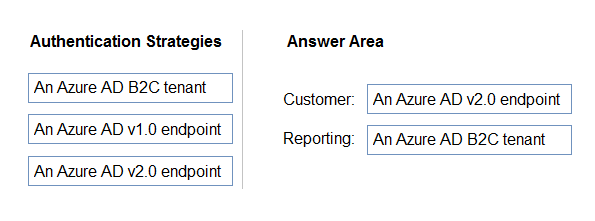

DRAG DROP -
A company named Contoso, Ltd. has an Azure Active Directory (Azure AD) tenant that uses the Basic license.
You plan to deploy two applications to Azure. The applications have the requirements shown in the following table.
Which authentication strategy should you recommend for each application? To answer, drag the appropriate authentication strategies to the correct applications.
Each authentication strategy may be used once, more than once, or not at all. You may need to drag the split bar between panes or scroll to view content.
NOTE: Each correct selection is worth one point.
Select and Place:

mmmore
Highly Voted 4 years, 5 months agoPinkee888
3 years, 1 month agosanketshah
4 years, 4 months agoWis10
3 years, 11 months agoKhabibcandefeatGSP
3 years, 12 months agopentium75
3 years, 9 months agoaspirin
Highly Voted 4 years agoAubinBakana
Most Recent 2 years, 9 months agovijeet
2 years, 11 months agoKent_020
3 years, 1 month agocloudera
3 years, 1 month agoplmmsg
3 years, 2 months agoarun
3 years, 2 months agozeeek
3 years, 2 months agosmonkey
3 years, 4 months ago17Master
3 years, 2 months agoBayleafSoftware
1 year, 7 months agoleo_az300
3 years, 7 months agosyu31svc
3 years, 7 months agoDhelailla
3 years, 8 months agoVenkatmr
3 years, 8 months agoKowser
3 years, 8 months agosouvik123
3 years, 8 months agoPerfumoPeru
3 years, 9 months ago